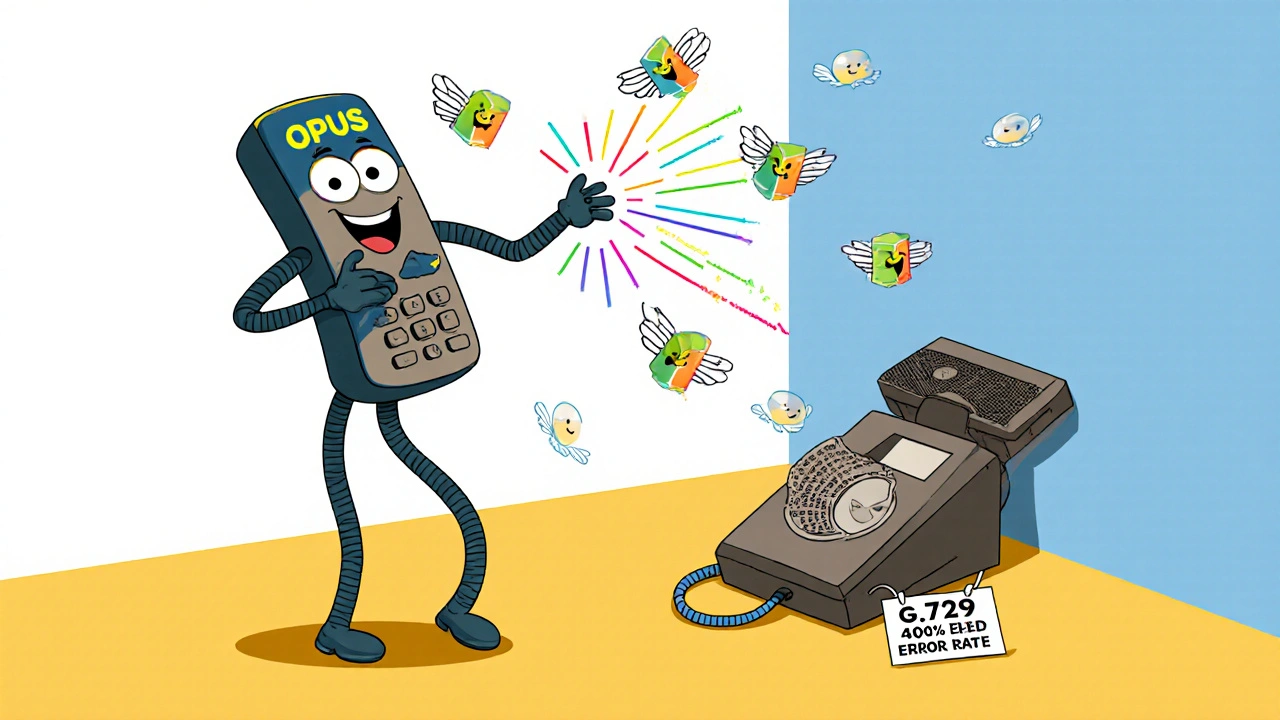Why Codec Compatibility Matters More Than You Think
If your VoIP calls sound robotic, cut out randomly, or drop entirely during peak hours, the problem isn’t your internet. It’s probably your codec setup. Codecs are the hidden translators that turn your voice into digital data and back again - and not all IP phones speak the same language. Even if your phone works fine for local calls, mismatched codecs between your device and your provider can wreck call quality across your entire network. The good news? Most major vendors list exactly which codecs their phones support. The bad news? Many IT managers still guess instead of checking.
What Are VoIP Codecs, Really?
Think of a codec as a voice translator. It takes your spoken words, squeezes them into small digital packets, sends them over the internet, and then rebuilds them on the other end. The trick is doing this fast enough that the conversation feels natural - and without using up all your bandwidth.
The oldest and most common codec is G.711. Introduced in 1972, it still powers most business phone systems today because it delivers clear, toll-quality audio. But it’s a bandwidth hog - using 80 kbps per call direction. That’s fine on a high-speed office line, but a nightmare over a slow remote connection.
G.729 is the opposite. It cuts bandwidth to just 24 kbps by compressing the voice heavily. That’s why it’s popular in branch offices and WANs. But there’s a catch: it breaks down fast if even 1% of packets get lost. And if you’re using voice AI assistants or automated attendants, G.729 makes synthetic voices sound unnaturally robotic.
Then there’s G.722. This wideband codec captures more of your voice - from 50 Hz to 7,000 Hz - making speech sound fuller and more natural. It’s perfect for executive calls or customer service lines where clarity matters. But it needs 80 kbps like G.711, so it’s not a bandwidth saver.
Enter Opus. Launched in 2012 but only now dominating new deployments, Opus adapts on the fly. It can drop to 6 kbps on a shaky connection or climb to 510 kbps when bandwidth is plentiful. It handles packet loss better than any other codec, has ultra-low latency (as low as 5ms), and works perfectly with AI voice systems. In 2025, Telnyx calls it the best voice codec for VoIP - and they’re right.
Which Codecs Do Major Vendors Support?
Not every phone supports every codec. Even within the same brand, older models may lack modern support. Here’s what you’ll find on today’s top IP phone lines:
- Cisco: The 7900 series (still widely used) only supports G.711 and G.729. Newer platforms like the 8800 and 9800 series add G.722 and Opus. Cisco Unified Border Element systems let you set codec preference lists to auto-negotiate the best option between devices.
- Yealink: All current models (T4x, T5x, W5x series) support G.711, G.729, G.722, and Opus. Yealink’s firmware updates often add Opus support even on older devices - check your model’s spec sheet.
- Grandstream: G.711, G.729, G.722, and Opus are standard on all current deskphones and conference units. Their GXW series gateways also handle transcoding between legacy and modern codecs.
- Poly (formerly Polycom): Newer SoundStation and VVX models support all four codecs. Older VVX 300/400 units may lack Opus unless updated to the latest firmware.
- Snom: Full support for G.711, G.729, G.722, and Opus across all current models. Snom is known for clean, transparent codec implementation.
- Fanvil: Supports all four codecs, but has separate configuration profiles for deskphones, doorphones, hotel phones, and Android-based phones. Their X series phones are optimized for Opus in cloud PBX environments.
- Aastra: Now part of Mitel, Aastra phones support G.711, G.729, and G.722. Opus support is limited to newer models and requires manual XML configuration.
- Htek and Intelbras: Budget-friendly brands that support G.711 and G.729 on most models. G.722 is available on mid-tier lines. Opus is rare - check firmware notes carefully.
Bottom line: If you’re buying new phones in 2025, insist on Opus support. If you’re keeping old hardware, make sure your PBX can transcode between G.711/G.729 and newer codecs.

Real-World Codec Strategy: What Works in Practice
Choosing codecs isn’t about picking the “best” one. It’s about matching the right tool to the job.
- For contact centers: Use G.722 on agent and supervisor lines. Call quality directly affects customer satisfaction scores. Use G.729 on internal lines to save bandwidth during peak hours. Avoid G.729 for voice AI - it mangles speech recognition.
- For remote workers: Set G.729 as primary, G.711 as fallback. Most home internet can’t handle 80 kbps consistently. If the worker has fiber or 5G, enable Opus for better clarity.
- For international offices: Watch out for G.711 variants. North America uses μ-law. Europe uses A-law. If your PBX doesn’t auto-detect, you’ll get garbled audio. Always enable transcoding between the two.
- For emergency services (E911): G.711 is required in most regions. Even if you use Opus everywhere else, your emergency call path must support G.711. Cisco and 3CX both confirm this in their compliance guides.
- For voice AI and automation: Opus is non-negotiable. G.729’s compression adds artifacts that confuse speech-to-text engines. Telnyx found 40% higher error rates with G.729 in AI call routing tests.
Large companies (1,000+ employees) use codec preference lists in 78% of cases, according to Cisco’s 2023 data. This lets the system automatically pick the best codec based on network conditions, device capability, and call type - no manual tweaking needed.
Common Mistakes and How to Fix Them
Here are the top three codec-related failures - and how to avoid them:
- One-way audio: This happens when one phone sends G.722 and the other only understands G.711. Solution: Always configure fallback codecs. If Opus is primary, set G.722 as secondary, then G.711 as last resort.
- High CPU load on phones: G.729 needs more processing power. Older or budget phones may stutter or reboot under heavy load. Solution: Use G.729 only on devices with modern processors. Stick to G.711 on low-end hardware.
- Transcoding bottlenecks: If your PBX has to convert G.729 to G.711 for every call, it can overload your server. Solution: Match codecs end-to-end where possible. Use devices that support the same codecs to avoid transcoding entirely.
Industry estimates say 15% of VoIP problems come from codec mismatches. Most are easy to fix - if you know where to look.

Future-Proofing Your VoIP System
By 2026, Telnyx predicts 85% of new voice AI deployments will use Opus. By 2027, 70% of enterprise VoIP systems will use adaptive codecs that change in real time based on network health.
That doesn’t mean G.711 is going away. It’s still the universal fallback. Every emergency system, legacy PBX, and international carrier still relies on it. But if you’re upgrading your phones or switching providers in 2025, Opus should be your baseline requirement.
Here’s your checklist:
- Confirm all new IP phones support Opus
- Upgrade firmware on older phones to unlock G.722 and Opus if available
- Configure codec preference lists in your PBX (Cisco, 3CX, etc.)
- Test call quality with AI assistants before full rollout
- Keep G.711 enabled for E911 and legacy compatibility
Don’t wait for a call to drop mid-conversation. Check your codec settings today - it’s the quietest upgrade that makes the loudest difference.
Frequently Asked Questions
What’s the best codec for VoIP in 2025?
Opus is the best codec for new VoIP deployments in 2025. It adapts to network conditions, uses as little as 6 kbps or up to 510 kbps, handles packet loss better than any other codec, and has ultra-low latency that makes conversations feel natural. It’s also the only codec recommended for voice AI systems. While G.711 remains the most compatible, Opus delivers superior quality and reliability.
Do all IP phones support Opus?
No. Older phones - especially Cisco 7900 series, some Htek and Intelbras models, and budget devices - don’t support Opus. Most current phones from Yealink, Grandstream, Poly, Snom, Fanvil, and newer Cisco models do. Always check the vendor’s official compatibility list or firmware release notes before assuming support.
Why does G.729 sound bad with AI voice assistants?
G.729 compresses voice so aggressively that it removes subtle vocal tones and frequencies that speech recognition engines rely on. This makes synthetic voices sound robotic and causes AI systems to mishear words. Telnyx testing showed up to 40% higher error rates in AI call routing when using G.729 versus Opus. Always use Opus or G.722 for any system that uses voice AI.
Can I use G.711 and G.729 together on the same network?
Yes - and you should. Most enterprise PBX systems use codec preference lists to allow mixed environments. For example, you can set G.729 as the default for internal calls to save bandwidth, and G.711 as fallback for legacy phones or emergency calls. The PBX automatically transcodes between them when needed. Just make sure your server has enough processing power to handle the transcoding load.
What’s the difference between G.711 A-law and μ-law?
They’re two versions of the same codec with slightly different compression math. A-law is used in Europe and most of the world. μ-law is used in North America and Japan. If your system connects to international numbers and doesn’t auto-detect the format, you’ll get garbled audio. Most modern PBX systems handle this automatically, but older ones may need manual configuration to enable transcoding between the two.
How do I check which codecs my IP phone supports?
Look in your phone’s web interface under Settings > Audio or Codec Settings. You can also check the vendor’s official compatibility matrix - Cisco, 3CX, and Yealink all publish detailed lists. For enterprise systems, review your PBX’s codec preference list settings. If you’re using 3CX, check the setupconfig.xml files for vendor-specific templates.










Write a comment